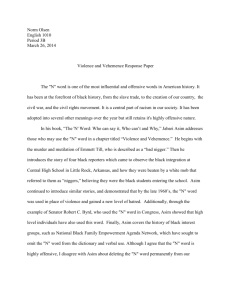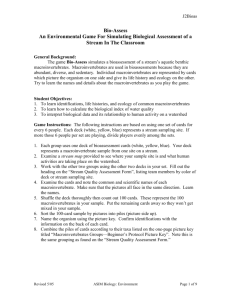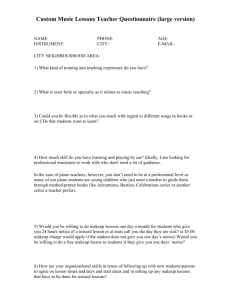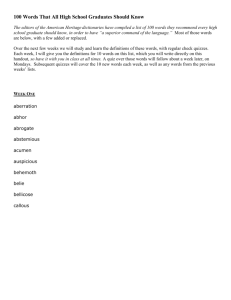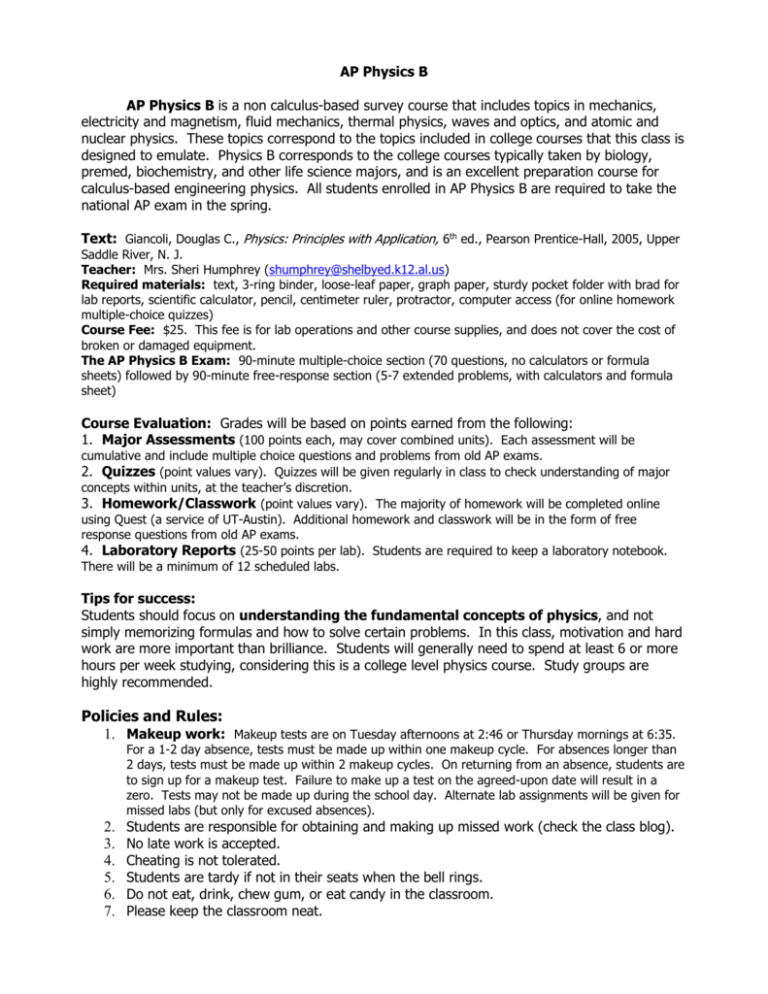
AP Physics B
AP Physics B is a non calculus-based survey course that includes topics in mechanics,
electricity and magnetism, fluid mechanics, thermal physics, waves and optics, and atomic and
nuclear physics. These topics correspond to the topics included in college courses that this class is
designed to emulate. Physics B corresponds to the college courses typically taken by biology,
premed, biochemistry, and other life science majors, and is an excellent preparation course for
calculus-based engineering physics. All students enrolled in AP Physics B are required to take the
national AP exam in the spring.
Text: Giancoli, Douglas C., Physics: Principles with Application, 6th ed., Pearson Prentice-Hall, 2005, Upper
Saddle River, N. J.
Teacher: Mrs. Sheri Humphrey (shumphrey@shelbyed.k12.al.us)
Required materials: text, 3-ring binder, loose-leaf paper, graph paper, sturdy pocket folder with brad for
lab reports, scientific calculator, pencil, centimeter ruler, protractor, computer access (for online homework
multiple-choice quizzes)
Course Fee: $25. This fee is for lab operations and other course supplies, and does not cover the cost of
broken or damaged equipment.
The AP Physics B Exam: 90-minute multiple-choice section (70 questions, no calculators or formula
sheets) followed by 90-minute free-response section (5-7 extended problems, with calculators and formula
sheet)
Course Evaluation: Grades will be based on points earned from the following:
1. Major Assessments (100 points each, may cover combined units). Each assessment will be
cumulative and include multiple choice questions and problems from old AP exams.
2. Quizzes (point values vary). Quizzes will be given regularly in class to check understanding of major
concepts within units, at the teacher’s discretion.
3. Homework/Classwork (point values vary). The majority of homework will be completed online
using Quest (a service of UT-Austin). Additional homework and classwork will be in the form of free
response questions from old AP exams.
4. Laboratory Reports (25-50 points per lab). Students are required to keep a laboratory notebook.
There will be a minimum of 12 scheduled labs.
Tips for success:
Students should focus on understanding the fundamental concepts of physics, and not
simply memorizing formulas and how to solve certain problems. In this class, motivation and hard
work are more important than brilliance. Students will generally need to spend at least 6 or more
hours per week studying, considering this is a college level physics course. Study groups are
highly recommended.
Policies and Rules:
1. Makeup work: Makeup tests are on Tuesday afternoons at 2:46 or Thursday mornings at 6:35.
For a 1-2 day absence, tests must be made up within one makeup cycle. For absences longer than
2 days, tests must be made up within 2 makeup cycles. On returning from an absence, students are
to sign up for a makeup test. Failure to make up a test on the agreed-upon date will result in a
zero. Tests may not be made up during the school day. Alternate lab assignments will be given for
missed labs (but only for excused absences).
2.
3.
4.
5.
6.
7.
Students are responsible for obtaining and making up missed work (check the class blog).
No late work is accepted.
Cheating is not tolerated.
Students are tardy if not in their seats when the bell rings.
Do not eat, drink, chew gum, or eat candy in the classroom.
Please keep the classroom neat.
General Course Outline
Unit
Title
Related Topics
1
OneDimensional
Motion
Math Review
Velocity
Acceleration
Kinematics
Horizontal and Vertical
Motion
Vectors
Projectiles
Relative Velocity
Suggested Labs
Text
Week
Numbers
(approximate)
GraphMatch Lab
(optional)
Ch. 1,
2
1, 2
Projectile Time of
Flight (ASIM)
Ch. 3
3
Newton’s 2nd Law
(ASIM)
Ch. 3,
4
3, 4, 5
Ch. 5
6, 7
Conservation of
Energy (ASIM)
Ch. 6
8, 9
Impulse/Momentum
Ch. 7
10, 11
Torque Activity
Ch. 8,
9
12, 13
Archimedes’
Principle Lab
Ch. 10
14, 15
Simple Harmonic
Motion (ASIM)
Speed of Sound
(ASIM)
Ch. 11,
12
16, 17
First Semester
2
3
Assessment 1
TwoDimensional
Motion
Assessment 2
Forces and
Motion
Assessment 3
4
5
6
Circular
Motion
Assessment 4
Work and
Energy
Assessment 5
Momentum
7
Assessment 6
Rotational
Motion
8
Assessment 7
Fluid
Mechanics
Assessment 8
9
Waves and
Sound
Newton’s Laws
Inertia
Normal Force
Free Body Diagrams
Friction
Uniform Circular
Motion
Gravitation
Centripetal Force
Kepler’s Laws
Work
Kinetic Energy
Potential Energy
Work-Energy Theorem
Energy Conservation
Power
Linear Momentum
Impulse
Collisions in one and
two directions
Angular Quantities
Torque
Translational/Rotationa
l Equilibrium
Static Equilibrium
Hydrostatic Pressure
Pascal’s Law
Buoyancy
Fluid Flow Continuity
Bernoulli’s Equation
Simple Harmonic
Motion
-Mass-Spring System
-Pendulum Motion
(ASIM)
10
Assessment 9
Heat and Laws
of
Thermodynamics
Wave Motion
Reflection
Interference
Superposition
Standing Waves
Resonance
Characteristics of
Sound
Doppler Effect
Temperature Scales
Thermal Expansion
Heat
Methods of Heat
Transfer
Kinetic Theory
Gas Laws
Laws of
Thermodynamics
Thermodynamic
Processes
Heat Engines
Entropy
Heat Transfer
(ASIM)
Heat Engine
Efficiency (ASIM)
Ch. 13,
14, 15
18, 19
Ch. 16,
17
1, 2
Equivalent
Resistance (ASIM)
Ohm’
Law/Kirchhoff’s
Rules (ASIM)
Ch. 18,
19
3, 4
Earth’s Magnetic
Field
Ch. 20,
21
5, 6
Concave Mirror
(ASIM)
Convex Lens
(ASIM)
Ch. 22,
23
7, 8
Assessment 10
Second Semester
11
Electrostatics and
Electrical Theory
Assessment 11
12
Current Electricity
Assessment 12
13
Magnetism and
Electromagnetism
Assessment 13
14
Light and Optics
Assessment 14
Charging Methods
Coulomb’s Law
Electric Force
Electric Field
Electric Potential
Capacitors
Current
AC/DC
Ohm’s Law
Power
Circuit Analysis
Kirchhoff’s Rules
Magnetic Field
Magnetic Force
Right Hand Rule
Solenoids
Faraday’s Law
Lenz’s Law
Induced emf
Transformers
Electromagnetic
Spectrum
Reflection
Refraction
TIR
Thin Lenses
15
Wave Nature of
Light
16
Assessment 15
Modern Physics
15
Assessment 14
AP Exam Review
Diffraction
-Single slit
-Double slit
-Grating
Thin Film
Interference
Polarization
Wave-Particle
Duality
Photoelectric Effect
Compton
Scattering
deBroglie
Wavelength
Atomic Spectra
Bohr Model
Energy Levels
Radioactive Decay
Half Life
Diffraction (Pasco)
Ch. 24
9, 10
Work Function
Ch. 27,
30
11, 12, 13
14, 15, 16
Oak Mountain High School Mission Statement:
The mission of Oak Mountain High School is to create an atmosphere of excellence where all students are encouraged
to achieve their academic, creative, and physical potential through dynamic instructional methods (including 21 st
Century skills), extracurricular experiences, and relationships among students, staff, parents, and the community.

